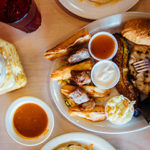
New England has chowder and lobster rolls; the South, grits and fried green tomatoes. New Orleans is known for gumbo, the Southwest has green-chili enchiladas, and California pioneered Asian fusion. But what springs to mind when you think of Midwestern cuisine?
Those who feasted on the seven-course meal cooked by chef Bill Glover at New York’s James Beard Foundation (JBF) House on September 11 can answer that handily: It can veer from rabbit confit and walleye tempura to jalapeño hush puppies and sweet-corn soufflé.

An invitation to cook at the JBF House is coveted among chefs, and Glover — the chef/owner of Gallerie Bar & Bistro at the Hilton Columbus Downtown — brought with him not only some of his team, but a few purveyors (a farmer, distiller, mixologist, and brewer among them) and a wealth of provisions sourced from Ohio farms, fields, woods, lakes, and rivers. The meal was dubbed “Columbus Calling,” and the chef took that name seriously: Glover sourced 100 percent of his ingredients from Ohio, almost eschewing lemons until he found some produced in an Ohio greenhouse. (I attended the dinner at the invitation of Experience Columbus, who partnered with the Hilton Columbus Downtown and Columbus to host the event).

Guests arriving for the dinner squeezed through the cramped JBF kitchen to the back garden for pre-dinner apps and drinks. Travis Owens, the owner of Columbus cocktail bar Curio, traveled to New York to mix drinks for the event with spirits from Columbus’ Watershed Distillery. Owens produced three signature drinks, including the boozy equivalent of comfort food: Gin-and-juices served in Capri Sun-style packets. After putting away platters of pork rillettes with carrot gastrique and whipped lardo (and a few other morsels), diners filed upstairs to the intimate second-floor dining room for dinner.

What followed were seven earthy, inventive courses that married French technique with indigenous Ohio foods such as smoked rainbow trout (paired with steelhead-trout tartare and ginger panna cotta, pickled fennel, and rye croutons); walleye tempura with lemon labne, cherry tomatoes, and roasted eggplant purée; and short-rib and sweetbread croquettes with sumac, “citrus lace,” and foraged red-ribbon sorrel. Each menu item was accompanied by notes from the chef; of a rabbit confit dish, for instance, Glover wrote, “This dish was inspired by two of my loves — my mother and the outdoors.” The rabbit was from Anderson Farms in Petaskala, Ohio, whose farmer was among the guests; the chef served the meat with black walnuts, native to Ohio, as well as sage gnocchi, smoked red cabbage, nasturtiums, “leek ash,” and a local-cheese emulsion.
After the servers carted away the last dish — sweet corn soufflé with honey sabayon and roasted apricots — guests on the edge of food coma supped on coffees spiked with Watershed’s nocino as Glover thanked his team and fielded questions. Glover’s parents beamed from a table as the chef explained how not thrilled they were when they learned their son wanted to bypass college “to cook.” We’re lucky he did: Twenty years later, Glover is helping define Midwestern food — both in Columbus and now, for New Yorkers’ famously fussy palates.




